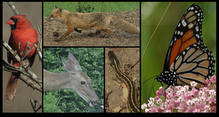Middleton Spider
Update: LB advises that this is a Golden Silk Orb-Weaver.
Wildlife observations from a suburban backyard adjacent to the Colvin Run Mill Park in Vienna, Virginia. Click on photos to enlarge.
Posted by
Gil Miller
at
6:20 PM
1 comments
![]()
Labels: 2008 Summer, On the Road, Spider
Posted by
Gil Miller
at
6:19 PM
0
comments
![]()
Labels: 2008 Summer, Eastern Gray Squirrel
On the way to the Pickering Creak Audubon Center, we came across one of the many ospreys nesting in and around the Chesapeake Bay. This is a majestic raptor that enjoys nesting on the many navigation buoys in the creeks and the bay. This one was about 20 yards off of a bridge just before the town of St. Michael's, Maryland - hey, if you are going to the Eastern Shore where else do you stop for lunch?
Posted by
Gil Miller
at
6:18 PM
0
comments
![]()
Labels: 2008 Summer, On the Road, Osprey
Posted by
Gil Miller
at
6:17 PM
0
comments
![]()
Labels: 2008 Summer, Butterfly, On the Road, Pickering Creek
This summer, we again took a quick road trip to the Pickering Creek Audubon Center on the Eastern Shore of Maryland. These photos show a number of Stilt Sandpipers, Short-billed Dowitchers, and Lesser Yellowlegs.
Posted by
Gil Miller
at
6:16 PM
0
comments
![]()
Labels: 2008 Summer, Lesser Yellowlegs, Pickering Creek, Short-billed Dowitcher, tilt Sandpiper
Posted by
Gil Miller
at
6:15 PM
0
comments
![]()
Labels: 2008 Summer, Hummingbird
One day, I decided to attempt some close-ups of the hummingbirds feeding near the window. To get the best photo, I opened the window to the porch. After about five minutes and lots of photos, I took up another position - forgetting to close the window.
As the more aggressive hummer returned, he bumped another one into the open window. We had a hummingbird in the house. The in-house hummer immediately went to the highest level (the ceiling) and had no way to get out. For the next 15 minutes, I struggled with how to get the hummer out, while the hummer struggled with exhaustion. During one point the hummer took a rest in one of my wife's summer wreaths hanging on the wall.
Posted by
Gil Miller
at
6:00 PM
0
comments
![]()
Labels: 2008 Summer, Hummingbird
Posted by
Gil Miller
at
3:30 PM
0
comments
![]()
Labels: 2008 Summer
Posted by
Gil Miller
at
3:19 PM
0
comments
![]()
Labels: 2008 Summer, Hummingbird
We began the second day of our Christmas road trip from the Colvin Run Habitat to Frisco, Texas, by leaving
A good number were hawks that we are familiar with - red-tails, red-shoulders, even a few sharp-shinned hawks. On three occasions, we observed red-tails swooping down from a post or tree to grab a small rodent. On two of these observations, the red-tail was parallel to the line of our travel. On one of these observations though, the hawk came right to left across the road to grab something on a very wide median - no problem as the hawk was well in front of us. However, after picking up the prey, the hawk made a U-turn and came back across the road. At that point, I had to swerve the car to avoid taking out the hawk with my windshield.
There were several hawks observed that are not frequently seen in the Habitat or on the East Coast. I believe that on two occasions, we believe we observed Golden Eagles. Even though we had observed several red-tailed hawks of considerable size, the size of these golden eagles was remarkable. Their all brown exteriors was in stark contrast to the white, white/brown, or reddish brown breasts of the other perched raptors. A quick bit of research showed that while the golden eagles do not nest in Arkansas, they do winter in Arkansas. We hope we got the observation correct.
Posted by
Gil Miller
at
3:18 PM
0
comments
![]()
Labels: Golden Eagle, On the Road, Red-Shouldered Hawk, Red-tailed Hawk, Sharp-shinned Hawk
Posted by
Gil Miller
at
3:00 PM
0
comments
![]()
Labels: 2008 Summer, On the Road, Peacock
I normally do not shoo the animals (well except for the crows) from the Habitat. But with the deer so numerous and frequent, I began a game of stalking the deer this summer. The position of the shrubs in the Habitat allowed me to get very close before the deer saw me. Of course with me close, as soon as they saw me, the deer would take off. Most times, I only got shots of their rears.
Of course, my stalking never deterred them coming back. In fact, as can be seen from this second photo the buck never lost even a green leaf - even in full stride.
The deer typically ran 30 yards and start eating again.
Posted by
Gil Miller
at
11:19 AM
0
comments
![]()
Labels: 2008 Summer, White-tailed Deer
While the deer usually come through as a family unit, every once in a while only one of the fawns are observed. The other are most likely nearby, but unseen by me.
There is nearly nothing that they will not eat. I have suggested taking our "National Wildlife Society Certification" sign down and replace it with one saying "Deer Salad Bar - Help Yourself."
My wife tried to keep them from eating her flowers this year with Tabasco sauce - I believe that the deer actually began to enjoy the flavor - nothing stops them.
The last two photos were taken about a month earlier than the first three.
Posted by
Gil Miller
at
11:55 AM
0
comments
![]()
Labels: 2008 Summer, Fawns, White-tailed Deer

This work is licensed under a Creative Commons Attribution-NonCommercial 3.0 License.
